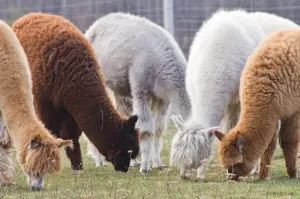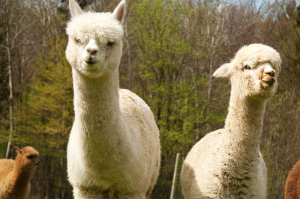What Alpacas Are Good for? Benefits & Uses
Alpacas have been domesticated into the farm animals they now are over many decades, and they bring a number of useful qualities to the table. They can be a good choice of animal to add to your homestead farm or to build a larger business with.
So, why are alpacas useful to own? The primary reasons people purchase alpacas are for fiber production, guarding other farm animals, to use as pack animals, for companionship, or for showing in competitions. Their meat and milk can be used as well; however, there are other animals that are far better suited for these roles.
Before deciding if alpacas are the right choice for you, read on for more information about the uses and benefits of keeping alpacas.
Common Alpaca Uses
Fiber Production
Alpaca wool, also called “alpaca fiber” or “alpaca fleece,” is a valuable commodity. Clothes and blankets made from the material are in high demand. Alpaca wool has been shown to be three times warmer than sheep wool. This is because each fiber is actually hollow in the center, which allows it to hold onto more body heat while also being lighter.
Additionally, alpaca fiber is softer and more comfortable than sheep wool for people with sensitive skin. Sheep produce lanolin, which is a mixture of chemicals produced by the sebaceous or oil-producing glands, to keep their skin hydrated and impenetrable from rain and cold weather. Unfortunately, not all of this lanolin is able to be washed off during the cleaning process. Alpacas, however, do not produce lanolin, which makes their wool softer and cleaner-feeling to all skin types.
Because of the length and silkiness of alpaca fibers, fabrics made from them are less likely to “pill” after use. This keeps the materials looking clean and new for longer than those crafted from other types of wool.
Alpaca fiber also wicks moisture from the body like sports clothing, making it an excellent choice for those who spend a great deal of time outdoors in conditions involving water or lots of sweating, as it will keep your skin dry better than other types of fabric.
Alpacas Can Be Used As Guard Animals 
Because alpacas are so protective of their herd, they can also make great watchdogs for the other farm animals they may come to include in their herd. They have been known to watch over and defend sheep and other animals just like their own kind from predators such as foxes and coyotes. Thanks to their impressive size and ability to spit, oftentimes predators will realize this fight isn’t worth it and will go in search of food elsewhere.
They’ve even been used solely as guard animals by farmers of other species. Sets of 3-4 alpacas would be placed in various parts of the property with different herds, and the animals were better protected and suffered fewer casualties.
Alpacas Can Be Used As Pack Animals
Unfortunately, alpacas are not great choices for riding animals. Their bodies are tall but fragile and can’t support much weight. They can, however, be used as lightweight pack animals. They’ve been used to carry packs since the beginning of their species’ domestication in the Andes, and they are still good for it.
Some farms offer alpaca expeditions to tourists during which they can go on a journey with an alpaca assigned to them to carry all their things for them.
Alpacas Can Be Used For Showing/Competing
Alpaca shows and competitions are held in order for people looking to sell alpacas to have the chance to show their alpacas off to potential buyers. People looking to purchase alpacas with any number of particular qualities can take the time to look over and observe performances by the various types of alpacas and make their purchasing choices.
There is a surprisingly large number of events alpacas can compete in. For starters, there are four main sections: halter class, production class, performance class, and fleece/fiber arts class. Each of those is broken down further by the age and color of the alpaca and even sometimes by the alpaca’s gender.
There are a number of large rings in which ten or eleven alpacas are judged at a time on various qualities. Usually, only six places are awarded, so after the judge has examined each animal extensively, those who will not be placed are excused from the ring. Then the judge assigns places, and buyers will pay more for those who placed most highly.
Alpacas cost anywhere from a few hundred dollars to several thousand. The better they perform at shows, the more valuable they will be to buyers.
Alpacas Can Be Used For Companionship
Alpacas can be good pets in some ways, but there are some cautions to consider. They are too big to live indoors but are fun to watch outside. They are herd animals, though, so it is necessary to have at least two alpacas to keep each other company.
Because of their size and their initial distrust and potential aggression toward any unfamiliar people, they are best handled by adults rather than children. And adult intact males should never be considered for use as a pet. Only females or castrated males are safe enough to become pets.
Even raising alpacas from birth can cause more problems than it can help in this area, as alpacas need to grow up around others of their own kind to learn the right manners and behaviors.
If you do choose to use an alpaca as a pet, it should be halter trained as soon as possible and regularly asked to wear the halter for a bit of time to keep them used to it. This will make it easier to transport them when needed and for them to receive vet care with as little stress as possible.
Alpacas Can Be Used For Meat Production
While they can technically be used for meat, alpacas are one of the least ideal farm animals to keep for meat production. Their meat is tasty and can make for a good occasional delicacy, however, it takes far more time and money to raise the animals to adulthood than their deer-sized bodies are worth for meat production. Fiber production is a much more lucrative choice for alpaca rearing.
There is, however, one situation in which it could be beneficial to sell alpaca meat. If you are breeding alpacas for another purpose, such as for fiber production or to produce show animals, and you produce some animals whose genes you do not want to use for future breeding, those animals can be culled and their meat sold.
In most cases, since alpaca is not recognized as a regular meat, it cannot be sold across state lines. However, many fine-dining restaurants in your area may be interested in purchasing limited amounts of alpaca meat from you. Some local private exotic meat enthusiasts may be as well. Because of the rarity of alpaca meat, it can be quite expensive. A single, raw, hind quarter shank costs $80.
Alpacas Could Be Used For Milk Production, But It’s Not Worth It
As with meat production, alpacas are not ideal farm animals for milk production. They produce a very small amount of milk which reportedly doesn’t taste good to humans. And their teats are so small that milking them by hand is extremely challenging.
Best to leave the milk production to cows and goats rather than alpacas.
The Number One Use For Alpacas Is Producing Fiber 
While the animals tend to be resistant to the process of shearing, if you are hesitant to raise an animal for meat production, fiber production might be a good option for you to consider.
A stressful shearing session once a year is easier on the soft-hearted farmer than when butchering time comes around.
Shearing Alpacas For Their Fiber
Shearing is the first part of the process and is usually done with scissors rather than clippers. Because of the size of an alpaca and the typical negative response to the shearing process, shearing usually requires at least one extra set of hands, if not two, to help with restraint.
While Alpacas are only shorn once per year, the right specimens with the right color of fiber can command a high price for their wool. Alpacas produce an average of 5-10 pounds of fiber per year. The raw, unprocessed fleece goes for around $10 per pound, but wool is worth much more at further stages of processing.
Skirting and Sorting
Skirting and sorting is the next part of fleece processing after shearing and involves removing any undesirable bits from the fleece and separating the more desirable fiber from the back and flanks away from the coarser wool of the neck and legs.
A skirting table is a table with a surface made from a kind of mesh material. The alpaca wool is laid over the mesh, and then the mesh is shaken lightly to encourage shorter bits of fiber and other undesirables, such as vegetable matter and bugs to fall through the mesh away from the fleece.
After shaking out the imperfections from the fleece, there are four criteria for sorting the fibers: color, hairiness, staple length, and grade. Alpaca fiber comes in 16 recognized colors, and color may vary a bit throughout an individual fleece, so you’ll need to separate out by color. Length is important because anything shorter than 1.5 inches will be too short to be processed like the rest of the wool and will need to go into a different pile, while anything longer than 6 inches is too long to be processed.
Further separation by grade must be done with a microscope. The grade is measured in microns, which is too small of a measurement to be seen by the naked eye. But the grade is important because it is a measurement of how soft the fibers are, which will affect what material and type of item the wool will be best for.
Once that process is complete, the fleece is worth around $28 per pound.
Roving and Batts
The next step is called “roving and batts” and involves pulling the fibers through a carding machine that cleans and aligns the fibers to some degree. Batts are produced first and can be further processed into roving by making a rope-like shape from the aligned fibers rather than having them in chunks. At this stage of processing, fleece is worth $50-$75 per pound.
Yarn
Yarn is produced next. The roving is taken to a spinning wheel and spun into thin strands. These strands may then be wound together to create thicker, more durable yarn. Finished alpaca yarn can sell for $100-$150 per pound.
Fabric
You might call the yarn the last step, but turning the yarn into blankets and clothing is the real final piece of the process. Items crafted from alpaca fiber yarn can be quite expensive. Depending on your skills and how much you want to get into it, you could go all the way to the blanket or clothing production point and sell your handmade clothes from handspun alpaca wool and keep all the profits rather than having to share with a middleman.
Now that you’ve learned so much about alpacas and their various uses, you are better equipped to decide whether you’d like to try raising these unique animals. Whatever you decide, best of luck! You can learn more about alpacas in my articles below or find my latest content here.

